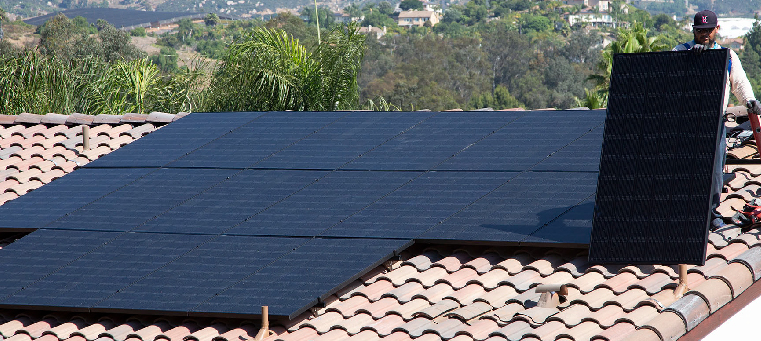




Do you dream of building a new home in California? If you’re planning to break ground on your Cali castle any time after 2020, then you’ll need to add a new element to your plans – solar panels. That’s because the Golden State made history earlier this year by becoming the first state in the United States to require solar panels on all new California homes. What’s in the fine print of this new rule, and how will it affect that dream home of yours? Most importantly, will it be a boon or a bust for your wallet?
To some degree, California’s revolutionary new rule isn’t such a surprise. For decades, our state has led the charge on adopting renewable energy and passing audacious clean energy legislation. In 2015, Governor Brown signed a law mandating that California receive at least half its electricity from renewable resources. (It looks like we may hit that goal 10 years early!)
Of all the renewable energy sources available, California has fallen the hardest and fastest for solar panels. By the end of 2017, our sun-soaked state received almost 16 percent of its power from solar, compiling a solar photovoltaic capacity of 19.8 gigawatts. That’s more than four times the amount of its nearest competitor (sorry, North Carolina)!
That’s why is wasn’t so surprising that on May 9th of this year, the California Energy Commission unanimously voted to require all new homes to include solar panels starting on January 1st, 2020.
How will this new requirement work? Let’s dive into the fine print.
First and foremost, the new requirement only affects homes built after January 1st, 2020. If your current home does not have solar panels, or if your home is under construction, you don’t have to worry about this rule. However, many of us plan or at least hope to move into a new home someday. So, what does this rule mean for you?
Solar panels are expensive. Fortunately, this new rule allows new home buyers to purchase or lease solar panels, so you don’t necessarily need to pay out of pocket for your solar panel system. Leasing your system means that the solar panel company owns the panels and covers the cost of installation. The solar company then charges you a set rate for the amount of electricity you use. Leasing can still help you save money, because typical costs are lower than what the utility companies charge.
The mandated solar systems only need to generate a minimum of 2 to 3 kilowatts (kW) per month, depending on the home’s size. An average solar system size is between 5kW and 10kW. A 2kW system is relatively small and likely won’t cover the entire energy demand of a typical home. That means new homeowners may be surprised to still receive an electric bill in the mail each month, though it will be noticeably lower than what they were charged in their previous, non-solar home.
The CEC’s ruling gives homebuilders two options on how they can meet the new regulation. They can either install solar panels on each new home they construct or build a “shared solar-power system” that can power a group of homes. This shared system might be ideal for condo complexes and possibly even larger planned communities. It will be interesting to see if this option creates a new shared solar-power system trend.
So, we’ve outlined the CEC’s new rule and looked more closely at how it actually works, but that doesn’t answer your most pressing question. How will the solar panel mandate actually affect the cost of your future dream home? Let’s look at the nickels and dimes.
According to the CEC, the new solar panel system will add around $9,500 to the cost of each new home. This is a serious pile of change, especially considering that California already has one of the most expensive housing markets in the country.
But don’t write off that dream home yet! Though you may end up paying more upfront for your home after 2020, the CEC believes that this new rule will actually result in significant cost savings for California homeowners. According to the CEC, “For residential homeowners, based on a 30-year mortgage, the Energy Commission estimates that the standards will add about $40 to an average monthly payment, but save consumers $80 on monthly heating, cooling and lighting bills.”
Put another way, the rule will give California households an expected savings of $19,000 over 30 years.
While it’s great to save money on your energy bills each month, it’s important to recognize that this new rule has a higher purpose. A state filled with solar-powered homes will help California meet its ambitious renewable energy goals.
California builds about 80,000 new homes a year. Currently, less than 20 percent of those homes include solar panels. The CEC estimates that solar energy generated as a result of the new rule would be equivalent to taking 115,000 cars off the road!
Solar panels in California have gone from being an affectation of the wealthy to becoming mainstream throughout the state. The CEC’s new rule only speeds up a trend that was already occurring. In fact, other states may follow suite. According to the New York Times, New Jersey, Massachusetts, and Washington D.C. are actively considering similar legislation.
If you plan on building a home or buying a newly built home after 2020, then solar energy is going to be part of your life. However, it might be worth considering solar panels for your current home now. After all, when you get ready to sell, solar panels will be much more commonplace. You might actually be at a disadvantage if your home doesn’t have a solar system.
If you’re ready to invest in solar panels in California to save on your energy costs and help our state meet its ambitious renewable energy goals, give us a call today. We have opened locations throughout California and are happy to offer homeowners a free energy analysis to help you determine if solar panels are right for your budget and energy needs.